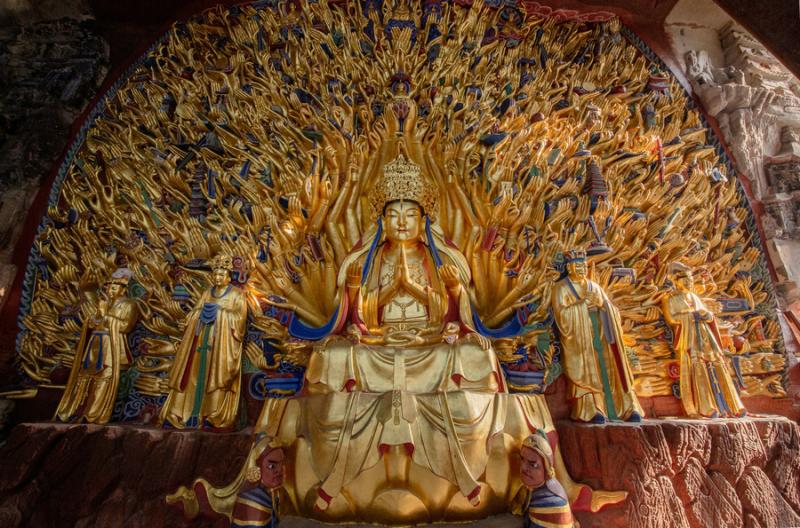Dedicated protector and expert bringing Dazu rock artwork to global attention
By: By TAN YINGZI in Chongqing

Dedicated protector and expert bringing Dazu rock artwork to global attention

Restoration of a statue of thousand-armed Avalokitesvara (Guanyin), a signature work among Dazu Rock Carvings was completed in 2015. [All photos provided to China Daily]
Over the past half century, Guo Xiangying has been doing just one thing.
"All I want to do is to make the world know more about Dazu Rock Carvings," says the 86-year-old. He is the retired founding director of the Dazu Rock Carvings Museum in Chongqing.
The museum, including a 5,000-square-meter permanent exhibition area, a circular-screen movie theater, seminar halls and a tourism center, is one of the largest of its kind in China.
Though he has retired from the post for years, Guo still devotes all his time to the preservation and research of this national treasure.
In January, Guo co-hosted with Shan Jixiang, president of Chinese Society of Cultural Relics, a TV program about China's world cultural heritage sites, where he shared his stories on the carvings.
The grottoes, which are spread over 100 locations in Chongqing's Dazu district, date back to the Tang Dynasty (618-907) and peaked in the Southern Song Dynasty (1127-1279). They are generally considered among the world's last such comprehensive rock carving artworks, and the five most representative locations were added to the UNESCO World Heritage List in 1999.
Among them, the cliffside carvings complex on Mount Baoding reflects the high point of Buddhism's adaptation in China.

A Southern Song Dynasty (1127-1279) statue of a bodhisattva in Yuanjue Cave among the Dazu Rock Carvings.
Guo was born into a scholarly family in 1936 in Tongliang district, Chongqing. He has loved painting since his childhood and has taught himself to be a veteran artist of Chinese painting.
In 1960, he became a teacher in Dazu and often went to the mountains drawing sketches of the grottoes.
The local cultural relics protection and management bureau noticed his interest in the rock carvings and asked him to work for the bureau.
At that time, cultural relics protection had long been neglected and underfinanced as the country was struggling with economic development.
"There were only two people working at the bureau, me and the director," Guo recalls.

A sleeping Buddha image is one of the most representative rock carvings in Baoding Mountain site of Dazu, Chongqing.
In 1974, Guo, then 37, started his new career alone on Mount Beishan, one of the five most representative locations of the rock carvings.
He lived in a shabby cottage in the middle of nowhere, with no running water or electricity. His job was simple-safeguarding the grottoes and taking notes about their conditions.
"I never thought about giving up, although the living and working conditions then were really challenging," Guo says. "I really love those rock carvings and enjoy being around them."
Dazu Rock Carvings were listed as a major cultural site under the national protection in the 1960s, but not until 1980 did the National Cultural Heritage Administration begin to build complete archives for the national treasures.
Local bureaus must provide the introduction and images of the cultural relics. With no camera or surveying and mapping instruments, Guo decided to draw the grottoes himself.

Dazu rock carvings are known to integrate explanation of Buddhist sutras with folk tales.
A 1-meter-long wooden ruler and a 20-meter-long tape measure were all he had. In the daytime, he and his colleague measured the carvings; at night, he drew the pictures on a large piece of paper under the kerosene lamp in his cottage.
"My nose was filled with black stuff from the burning kerosene," he says.
After three years of hard work, Guo completed a 23.15-meter-long scroll of all the major stone statues on Mount Baoding and Mount Beishan.
Thanks to his contributions to rock carving, Guo was selected as a deputy county head in charge of culture and tourism in 1984, which gave him an idea to promote Dazu Rock Carvings to the world by applying for the UNESCO World Heritage Site.
In the 1980s, China had only five UNESCO World Heritage sites, including the Forbidden City in Beijing and the Mogao Caves in Dunhuang, Gansu province.
The preparations for the application took years. In 1990, Guo quit as deputy county head after serving two terms and founded Dazu Rock Carvings Museum, a major step on the road to the UNESCO list.

Dazu rock carvings are known to integrate explanation of Buddhist sutras with folk tales.
At the 23rd session of the World Heritage Committee in Marrakech, Morocco, in 1999, Dazu Rock Carvings were finally presented to international experts. But due to limited application materials and language barriers, many experts could not fully understand the value of the Dazu grottoes and the site might fail to pass evaluation.
"I suddenly thought of my paintings of those grottoes which could explain everything," Guo says.
When the 23.15-meter-long scroll spread in front of the experts, they were fascinated by the number and aesthetic quality of the stone statues.
The carvings have attracted millions of visitors from home and abroad. Now, about 300 young Chinese researchers work at the museum.
"I have made those rock carvings rock again," Guo says.

A statue of Avalokitesvara (Guanyin) from Beishan Mountain site of Dazu Rock Carvings.





Love it when I see an 86 year old man whose first language is not English say: "I have made those rock carvings rock again." LOL. These fantastic rock carvings are in Chongqing, a three hour drive from where I am, and I do hope to see them one day. Although I have been to and seen 11 of China's 55 UNESCO Heritage sites, I don't want to miss this one.
Will post a link to this on Three Day Weekend Article.
Thank you.